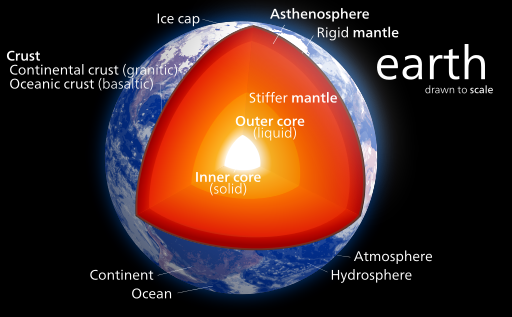Dr. Mike Bergman's New Study on Earth’s Inner Core Leads to NSF Grant
Dr. Michael Bergman, professor of physics at Simon’s Rock, began studying the earth’s inner core decades ago. His research on the center of the earth has helped broaden our understanding of the most remote part of our planet. Recently, his study on the irregular properties detected in the inner core and its possible correlation to localized melting was published in Geophysical Research Letters, earning him and his colleagues a National Science Foundation (NSF) grant of $138,000. Professor Bergman's research team includes physics student and first author James Yu ‘13, and scholars Dr. Ludovic Huguet and Dr. Thierry Alboussiere. Yu played a leading role in conceiving and carrying out the experiments, a rarity in undergraduate research.
The inner core of the Earth (home to the highest temps and greatest pressure) is solidifying
and growing from the molten outer core. Despite the fact that our planet is hottest
at its center, iron (Fe) freezes at the core due to extreme pressure. Large earthquakes
send seismic waves through the inner core, and seismometer recordings (which reve als the type of material waves travel through by way of the waves’ speed) show the
inner core exhibits unusual properties with unknown origin. Attenuation—which is the
damping of seismic waves or the restraining of vibratory motion—has been found to vary in the inner core. Dr. Bergman and other physicists believe this relates to the structure of the inner core’s iron
alloy. Although the inner core is, on average, growing radially outwards over time,
there may be regions of localized partial melting.
als the type of material waves travel through by way of the waves’ speed) show the
inner core exhibits unusual properties with unknown origin. Attenuation—which is the
damping of seismic waves or the restraining of vibratory motion—has been found to vary in the inner core. Dr. Bergman and other physicists believe this relates to the structure of the inner core’s iron
alloy. Although the inner core is, on average, growing radially outwards over time,
there may be regions of localized partial melting.
Bergman, Yu, Huguet, and Alboussiere simulated the possible inner core structure by solidifying and then partially melting a Pb-Sn alloy. Their findings suggest that variations in attenuation could be due to structural changes in the inner core. The research team will use their 3-year NSF grant to further test this hypothesis.
Read the study here.
Photo: © Kelvinsong / Wikimedia Commons / CC-BY-SA-3.0